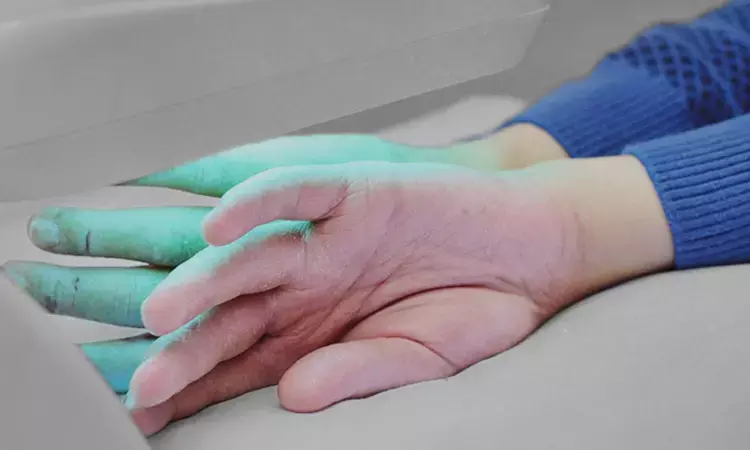- Home
- Medical news & Guidelines
- Anesthesiology
- Cardiology and CTVS
- Critical Care
- Dentistry
- Dermatology
- Diabetes and Endocrinology
- ENT
- Gastroenterology
- Medicine
- Nephrology
- Neurology
- Obstretics-Gynaecology
- Oncology
- Ophthalmology
- Orthopaedics
- Pediatrics-Neonatology
- Psychiatry
- Pulmonology
- Radiology
- Surgery
- Urology
- Laboratory Medicine
- Diet
- Nursing
- Paramedical
- Physiotherapy
- Health news
- Fact Check
- Bone Health Fact Check
- Brain Health Fact Check
- Cancer Related Fact Check
- Child Care Fact Check
- Dental and oral health fact check
- Diabetes and metabolic health fact check
- Diet and Nutrition Fact Check
- Eye and ENT Care Fact Check
- Fitness fact check
- Gut health fact check
- Heart health fact check
- Kidney health fact check
- Medical education fact check
- Men's health fact check
- Respiratory fact check
- Skin and hair care fact check
- Vaccine and Immunization fact check
- Women's health fact check
- AYUSH
- State News
- Andaman and Nicobar Islands
- Andhra Pradesh
- Arunachal Pradesh
- Assam
- Bihar
- Chandigarh
- Chattisgarh
- Dadra and Nagar Haveli
- Daman and Diu
- Delhi
- Goa
- Gujarat
- Haryana
- Himachal Pradesh
- Jammu & Kashmir
- Jharkhand
- Karnataka
- Kerala
- Ladakh
- Lakshadweep
- Madhya Pradesh
- Maharashtra
- Manipur
- Meghalaya
- Mizoram
- Nagaland
- Odisha
- Puducherry
- Punjab
- Rajasthan
- Sikkim
- Tamil Nadu
- Telangana
- Tripura
- Uttar Pradesh
- Uttrakhand
- West Bengal
- Medical Education
- Industry
Phototherapy Proven Effective for Asian Pediatric Atopic Dermatitis, Study Shows

Researchers have found in a recent study that phototherapy is an effective second-line treatment for moderate-to-severe atopic dermatitis in the Asian pediatric population. The study highlighted its benefits over oral systemic immunosuppressants. The study was published in the journal Photodermatology Photoimmunology and Photomedicine by Chia SY and colleagues.
This prospective study, led by Shi Yun Chia of the Department of Pediatric Medicine, KK Women's and Children's Hospital, Singapore, gives a different perspective on this modality of treatment. The research indicates clearly that phototherapy is a realizable second-line therapy, especially in comparison with oral systemic immunosuppressants.
This study of patients younger than 18 years who were treated with phototherapy for atopic dermatitis at KK Women's and Children's Hospital from January 2017 to December 2020. Subjects were identified by the hospital's phototherapy database, and clinical photographs before and after treatment were captured. Disease severity was independently rated by pediatric dermatologists using either a 5-point IGA or EASI. Data regarding demographic information, duration of disease, and associated medical conditions were also recorded. Duration of treatment, phototherapy modalities, number of sessions, maximum dose, response to therapy and complications if any were accurately noted and recorded.
The study used narrowband ultraviolet B (NBUVB) in a phototherapy cabinet, with initial doses ranging from 250 to 400 mJ/cm² based on Fitzpatrick skin types II–VI. Dose increases of 10%–20% were applied based on erythema responses. Some patients received a combination of UVA and NBUVB, starting with 1 J/cm² UVA and 100 mJ/cm² NBUVB, regardless of skin type. Photochemotherapy (psoralen + UVA, or PUVA) was employed for severe hand and foot dermatitis, with initial UVA doses of 1 J/cm² and increments of 0.5–1 J/cm².
• The study included 62 children aged 4–16 years, with 60% male and 40% female participants. Most had moderate to severe atopic dermatitis.
•60.3% had initial body surface area (BSA) involvement of 31%–60%, and 13.8% had BSA involvement of 61%–90%.
• Mean reductions in EASI scores were 11.4 for NBUVB and 7.9 for combined UVA and NBUVB phototherapy.
• Common side effects included pruritus, xerosis, erythema, and pain. Two patients receiving PUVA developed post-UVA burns and subsequently withdrew.
• Treatment outcomes were successful in 56.9% of patients, and significant improvements in IGA and EASI scores were noted.
• In 86.2%, compliance was good; in 12%, fair; and in 3.4%, lost to follow-up.
Phototherapy offers a lot of advantages in the management of moderate-to-severe atopic dermatitis in children within the Asian population. Researchers highly recommend it as a second-line treatment, proving its efficacy with easily manageable side effects in comparison with oral systemic immunosuppressants.
Reference:
Chia SY, Chee EEC, Wee LWY, Koh MJA. Phototherapy for the treatment of atopic dermatitis in Singaporean children and adolescents. Photodermatol Photoimmunol Photomed. 2024; 40:e12986. doi:10.1111/phpp.12986.
Dr Riya Dave has completed dentistry from Gujarat University in 2022. She is a dentist and accomplished medical and scientific writer known for her commitment to bridging the gap between clinical expertise and accessible healthcare information. She has been actively involved in writing blogs related to health and wellness.
Dr Kamal Kant Kohli-MBBS, DTCD- a chest specialist with more than 30 years of practice and a flair for writing clinical articles, Dr Kamal Kant Kohli joined Medical Dialogues as a Chief Editor of Medical News. Besides writing articles, as an editor, he proofreads and verifies all the medical content published on Medical Dialogues including those coming from journals, studies,medical conferences,guidelines etc. Email: drkohli@medicaldialogues.in. Contact no. 011-43720751


